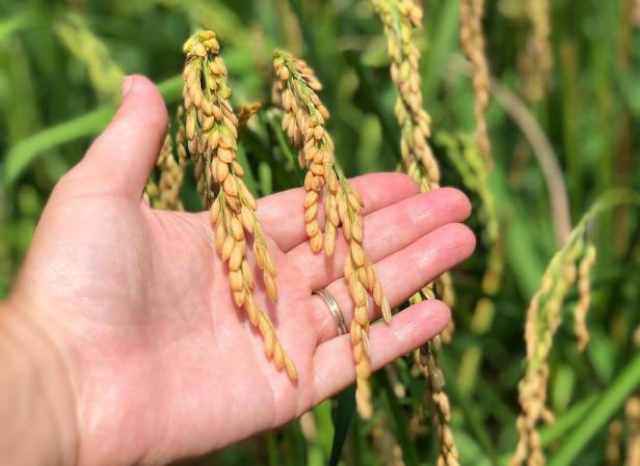I didn’t think there was any question that brown rice is better for you than white rice. Until I viewed a recent post passed to me by Sister Erin. It claims, “The nutritional gap between the two isn’t that large.” But how does the author define ‘nutritional value’?
 Rice: On the stem. With all it’s bran, germ and endosperm still intact…
Rice: On the stem. With all it’s bran, germ and endosperm still intact…
I just had to push back on Dr. Karan Raj’s assertions. Which I find ludicrous. Or at least overly simplified. And which immediately got my hackles up.
The basic difference
The difference between common white rice and brown is rice is like that between night and day.
Brown rice is the whole grain. It contains the outer bran husk, the germ and the endosperm. The germ is the part of the rice grain that sprouts and grows if you plant it under the right conditions. The endosperm is just a big, starchy lump of food to get the sprouting plant started on its stem- and root-building journey. The bran is a protective husk. It’s the part that’s brown. And it provides mechanical fibre in your duet.
White rice consists solely of the endosperm, stripped of the bran and germ during processes known as milling and polishing. It may look nicer, and fluff up nice in your rice cooker. But it definitely has lost many of the beneficial components that it started with.
Nutritional differences
We’ve already related the fundamental structural differences between white and brown rice. What about the nutritional ones?
Fibre
First, you need a certain amount of fibre (the bran) in your diet for healthy digestion and bowel movements. A 2012 study in the Journal of Food Science and Technology defines fibre as, “…that part of plant material in the diet which is resistant to enzymatic digestion which includes cellulose, noncellulosic polysaccharides such as hemicellulose, pectic substances, gums, mucilages and a non-carbohydrate component lignin.”
Non-scientists often refer to fibre as ‘roughage’: “Keeps you regular!”
Broadly, fibre is found in the cell walls of many vegetables, the bran on whole grains, substances such as pectin (the stuff that causes jams and jejlies to thicken), and other more-exotic (But less well-known) components of most common foods.
Germ
This is the smallest part of a whole grain, but it packs a lot of nutritive punch. It’s been used as a superfood by pro athletes and health-conscious types for ages. Heard of Wheat Germ? Cream of Wheat? Cream of Rice?
Endosperm
As we hinted earlier, this is mainly a starchy mass meant to nourish the germ as it sprouts and grows into a new plant. And it’s what most of us think of when we think of ‘rice’. But it lacks many of the benefits offered by the whole grain.
What Raj says
At first, I thought Raj (pictured, top of page) was in basic agreement with me, that brown rice has lots more nutrients and healthy fibre than plain white, milled rice. But about half way through his video, he starts ‘yes, butting’ himself.
For one thing, he claims many brands of white rice are enriched with nutrients lost in milling. But that’s really just admitting, they shouldn’t have been removed in the first place. Not a great endorsement for white rice, in my book.
Raj also claims, “The nutritional gap between both [types of rice] isn’t that huge,” though he added, “brown rice does have a nuttier flavour profile ― and it has a lower glycemic index.” That offhand remark about the glycemic index of brown rice is actually pretty significant to many folks with metabolism issues – particularly those who struggle every day to control their blood sugar levels.
Granted, he does allow that, “It might be a better option to consider compared to white rice if you’re diabetic.”
In his summation, Raj declares, white rice and brown rice are, “pretty comparable.”
My take
As you read my analysis of Raj’s post, or view his video (linked), you may come to realize that he thinks of nutrients as being restricted to ‘chemical’ components, such as protein, vitamins and minerals. He doesn’t appear to allow that fibre is also critical to our diets, and classes it as… Something else?
I also noted that he downplays the role of the germ as a nutrient source. True, the germ is physically the smallest part of the rice grain, but it may pack the most nutrition value – even as Raj defines it.
My summation: Use common sense and well-documented medical and dietary advice be your guide when choosing any whole grain over any refined (milled) one.
~ Maggie J.

